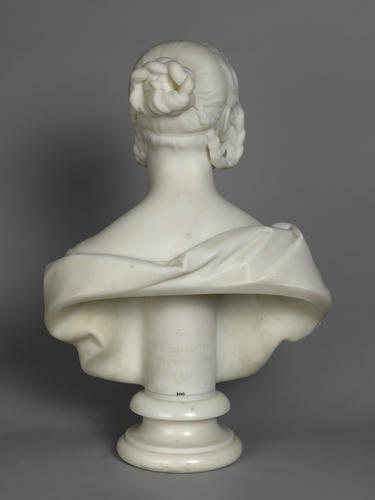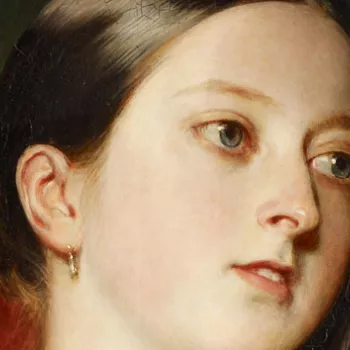Sir Francis Chantrey (1781-1841)
Queen Victoria (1819-1901) 1838-41
Marble | RCIN 31618
-
It was Chantrey's distinction to portray four different sovereigns during their lifetimes. Queen Victoria declared her intention of sitting to him on 14 October 1838 when she was still only 19. The commission, delivered via the Marquess Conyngham, is recorded in the sculptor's ledger for 1838. Despite his great experience the sculptor was daunted by the Queen's tender age and the need to give the portrait a proper sense of majesty.
There were seven sittings in all between January and March 1839, with the piece concluding on 1st February 1840 when Chantrey made the finishing touches to the marble. Two of his initial pencil studies of the Queen, which are in the National Portrait Gallery, were made using camera lucida. This device helped Chantrey to make accurate line drawings of his sitters, compensating for blindness in his right eye. These sittings were brief and Victoria was at liberty to write letters and hold conversations, as it is noted that the sculptor preferred a dynamic subject from which he could capture a characteristic attitude. On 1st April 1839 the clay model was complete, and Victoria comments that she 'went to look at Chantrey's bust, which he brought and which is quite finished and perfect'. Chantrey then made a cast of this model in plaster, preferring to work from this medium due to clay's instability when dry. This original plaster model still exists and is in the Ashmolean Museum, Oxford (NBP 774).
To assist the process of paring the down the original marble block, Chantrey had developed a 'pointing machine', a measuring implement composed of movable arms and a sliding needle, that allowed assistants to carve away exactly the correct amount of marble to produce a rough version of the model known as a 'marble bust in embryo'. The marble carver in Chantrey's studio, named James Heffernan, transformed this rough copy into a finished work of art for Chantrey to provide his final flourishes. The resulting bust, probably the last that Chantrey touched with his own chisel, became widely known through reproduction on coins and medals, and in a miniature bronze version published by the Art Union in 1848. It is shown in the Grand Corridor in 1846 (no 410).
Further versions were ordered by Queen Victoria for her father-in-law (now in the Furstenbau in the Veste Coburg) and for Sir Robert Peel (now London, National Portrait Gallery).
Text adapted from Royal Treasures, Queen's Gallery, London, 2002 and Sculpture Victorious, Tate Britain, 2015 (MG Sullivan).Provenance
Commissioned by Queen Victoria in 1838 (£210).
-
Creator(s)
Acquirer(s)
-
Medium and techniques
Marble
Category
Object type(s)










